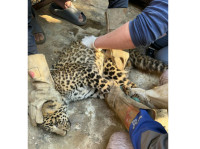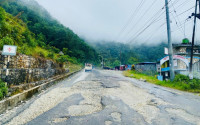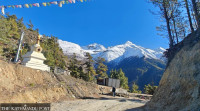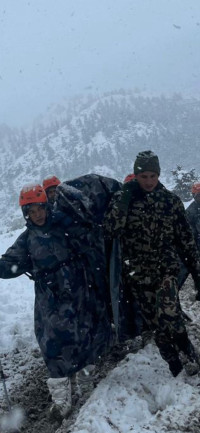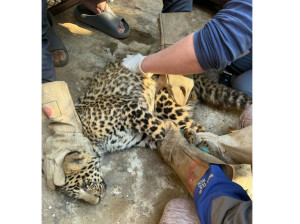Gandaki Province
Daunne stretch of Butwal-Narayanghat road becomes a mud trap again
Temporary diversion swept away. Tuesday’s rain has turned the road into muck, and left vehicles and travellers stuck along a 50-km length of highway.
Narayan Sharma
A relentless overnight rain turned the notorious Daunne stretch of Butwal-Narayanghat section of the East-West Highway into a muddy road, trapping hundreds of vehicles that caused kilometres long traffic jams. There was a traffic jam stretching about 50 kilometres, from Bhutaha in Nawalparasi West to Danda in Nawalparasi East by Wednesday evening.
The chaos began at around 2 am on Tuesday night when several trucks got stuck in thick mud near Daunne, halting traffic in both directions. With ambulances stranded and buses packed with passengers unable to move, travelers endured traffic jams for hours in sweltering heat and dust, left with no choice but to sleep in their vehicles or roadside lodges.
“There is no government here. Just look at this road. What kind of country would leave the road in such a pathetic condition?” Mohan Dev Nath expressed his frustration with the Post. He was stuck with his family in Dumkibas since early Wednesday. They were heading for Dhangadhi of Kailali district from Kathmandu.
Hundreds of vehicles were stranded in the jam, leaving a huge number of people in hardships. “It’s been 17 hours now. The sun is brutal, there’s no water, no food. We’re ready to take to the streets,” said Ramakanta Parajuli, travelling to Butwal from Pokhara with children.
Daunne, a 14-kilometre long treacherous hilly section of the East-West, has been a recurring crisis every monsoon for the past six years. Even light rain transforms the road into a muddy trap. The core problem lies in the state of the highway's ongoing expansion and the poor handling of the terrain.
At least four medium-sized bridges are still under construction along the Daunne-Dumkibas stretch. Some have had their decks half-poured; others have large open pits on one side, allowing only one vehicle at a time to cross. Worse, the Binayi stream diversion—meant as a temporary replacement for a collapsed steel bridge six months ago—has been swept away seven times so far.
“Each time we lay gravel and try to build the diversion, floods wash it away,” said an engineer overseeing the Binayi stretch. “There’s no way to ensure stable access during the rains.”
The result is a bottleneck. When one section becomes impassable, vehicles pile up behind it, creating a long traffic jam over the entire 45-kilometre stretch. “One truck gets stuck in the mud, it goes off track and no one else can move. This happens every week now,” said a bus driver.
Chief District Officer Bhabishwar Pandey said the administration deployed 77 police personnel across Nawalparasi East to prevent vehicles from entering the jam zone. "We’re holding back empty trucks and prioritising passenger buses and ambulances once the road opens," he said.
But Pandey did not hold back his frustration. “I’ve told the contractor to fill the giant pits left around the unfinished bridges, even temporarily. They say it costs too much. The Department of Roads won’t respond and when we call them, they just switch off their phones,” he fumed. “Is building a highway the responsibility of the CDO and police or the Department of Roads?”
The Narayanghat–Butwal road section, which includes the 14-kilometre Daunne hill stretch, is currently under expansion. The expansion work further exacerbates the road condition in the Daunne area. The area has been quite prone to landslides after the hillside was cut for widening the road.
The highway expansion contract was awarded to China State Engineering Corporation. Locals and officials claim the contractor has done virtually no work in the Daunne area for over four years. "They always say monsoon damage isn’t their responsibility. If that's true, who is responsible?" asked Ghanashyam Giri, chairman of Binayi Triveni Rural Municipality.
“I’ve called them hundreds of times. No response. If we can’t compel them to work, then at least station a full technical team here with equipment to respond during emergencies. People are calling me all night—‘why isn’t the jam cleared?’ What can I say?” Giri Lamented.
The Daunne section, a 14-kilometre stretch of winding, hilly terrain, was fully dug out for expansion but left unfinished. Only a two-kilometre portion from Bardaghat towards Daunne has been blacktopped. The rest is a mix of mud, gravel and debris. When it rains, the fine dust turns into slush nearly four feet deep.
This is not a new problem. For six years, the same headlines have surfaced every monsoon: Daunne jammed, travelers stranded, roads washed away. Until the bridges are finished, the diversions reinforced and the contractor held to account, Daunne remains a dangerous bottleneck along the Butwal-Narayanghat road section.
There is not an alternative road to the Daunne section. A 14-km dirt road connecting Bardaghat Municipality of Lumbini Province and Dumkibas of Binayi Triveni Rural Municipality of Gandaki Province is the proposed alternative to the Daunne section (Bardaghat-Dumkibas) of the East-West highway. But the road construction is left incomplete.
The Butwal-Narayanghat section is one of the busiest roads on the East-West Highway. It is a major road linking Lumbini, Karnali, and Sudurpaschim provinces to the national capital and other parts of the country. Over 18,000 vehicles use the route daily.
In view of the traffic congestion, the Department of Roads signed an agreement with the China State Construction Engineering Corporation to implement the road project in February 2019. As per the project agreement, the existing two-lane road is to be widened to six lanes in market areas, four lanes in forest areas and three lanes in the Daunne hill section. The contractor had divided the Narayanghat-Butwal road into two sections—48-km Daunne-Gaindakot section and 66-km Daunne-Butwal section.




 11.12°C Kathmandu
11.12°C Kathmandu.jpg)
